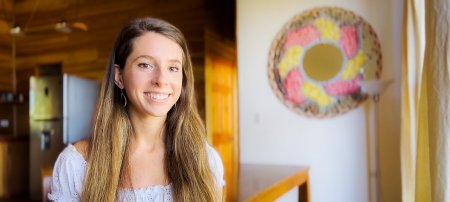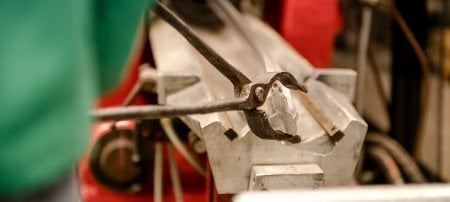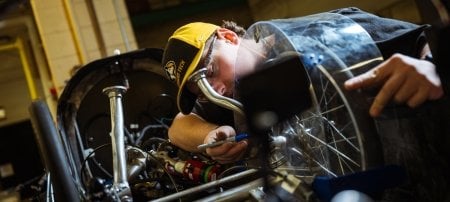Two Michigan Tech Teams Take Sustainable Designs to Washington, DC

Billions of people worldwide burn animal dung, crop residues, wood and charcoal to cook their meals. And the chemicals produced and inhaled sicken or kill millions. At particular risk are women who prepare their families’ food and children 5-years-old or younger.
Up to now, most interventions have focused on improving the cookstove to lower emissions. And that would be fine, if there were enough improved cookstoves to go around. But there aren’t. In 2012, only 2.5 million improved cookstoves were distributed, improving the household air pollution situation for exactly one-half of 1 percent of the world’s biomass burners.
So an interdisciplinary team of Michigan Technological University students took a different tack. They decided to look for ways to improve the cooking environment, not just the stove. And they found a low-cost, highly effective way to reduce the impact of cooking over biomass fires without designing and installing high-tech, costly stoves.
Better ventilation.
Now the Michigan Tech students—and another team that is working to turn a deadly byproduct of aluminum production into safe, useful products—have been invited by the Environmental Protection Agency to take their work to Washington, DC, to participate in the EPA’s annual Sustainable Design Expo. Known as P3 (People, Prosperity and the Planet), the competition challenges college and university teams to design and develop sustainable technologies to help protect the world’s health and the environment.
They will present their work—supported by $15,000 EPA grants—at a National Sustainable Design Expo April 18-19 in the nation’s capital. There, 45 college teams will compete for an additional $90,000 grant to move their design to real-world application
The cookstove project was born in small town on the Guatemalan border with Mexico, where Michigan Tech environmental engineering graduate student Kelli Whelan was working on an Engineers Without Borders project. She noticed that the kitchen of a family who had built an attic to insulate their house from a hot aluminum roof was much cooler than others she had visited, although they all used the same kind of wood-burning cookstove.
“That made me wonder if the temperature difference helped clear the smoke out, either by a draft or the greater temperature differential between the fire and the surrounding space,” she explains.
When she returned to Michigan Tech, Whelan and several fellow environmental engineering graduate students started work on a project to explore the situation. They built both a working model of a biomass cookstove and a computer model to test different kitchen and cooking conditions.
After receiving the EPA P3 grant, they surveyed Peace Corps Master’s International and Pavlis Global Technological Leadership Institute students at Tech who had worked in countries where biomass-burning cookstoves are used. They also conducted more physical and computational model tests, 57 of them, testing for the presence and transport of particulate matter, carbon monoxide and carbon, as well as comparing wind speed, temperature, humidity, roofing materials, wall height, cookstove placement and windows and doors open or closed.
“Our focus was not on ventilation, but on trying to determine which factors really influence the air quality in a kitchen and which do not,” said Whelan.
They discovered that ventilation is very important. “The improved cookstoves, which are supposed to reduce emissions, actually made the air quality worse under completely enclosed conditions,” she said. “In contrast, we saw the greatest reduction in ambient particulate matter and carbon monoxide with an improved cookstove and with windows and doors open.”
They also learned that not all ventilation helps. “Having two windows open on opposite ends of the kitchen was best, whereas having all the windows and doors open was worse,” Whelan said. “This is because having all outlets open creates turbulence inside the kitchen, and the smoke is not forced out.”
The studies also showed huge spikes in air contaminants when the fire was first ignited or extinguished. “Cookstove users should be made aware of this and taught to leave the space for a few minutes after lighting the fire or use sand to put it out,” the environmental engineering student suggested.
Abram Peterson, an environmental engineering undergraduate at Michigan Tech, recalls how the cookstove threat came alive for him in rural southern India last summer, where he was working as a member of the university’s Pavlis Institute for Global Technological Leadership.
“One of my most striking observations was the condition of some of the young children's voices,” Peterson says. “I noticed that the children who came from households that burned biomass for cooking had strikingly different sounding voices than those who came from households that used liquefied petroleum gas (LPG) for cooking. The children from the biomass-burning households had very raspy voices, similar to an adult who has smoked for many years. I am sure that the health effects on these children go much beyond the sound of their voices.
“When I came back to Michigan Tech and had the opportunity to work this project, I took it because I will probably not have another opportunity to work on a project that has the potential to help so many people in so many places. Our findings from this project not only have the potential to help the children that I met in India, but billions of others around the world who live in households that burn biomass to cook their food.”
The cookstove project team includes Mark DeYoung and Jonathan May, mechanical engineering; Travis Wakeham, anthropology and biological sciences; and Jarod Maggio, Abram Peterson, Mollie Ruth, Kelli Whelan and Alex Wohlgemuth, environmental engineering. Their faculty advisor is Kurt Paterson, associate professor of civil and environmental engineering. Maggio is a PhD candidate. Whelan is studying for a master’s degree, and Wohlgemuth is in the Peace Corps Master’s International program.
Also at the EPA Expo will be a team of Michigan Tech students and their advisor whose work focuses on turning a deadly byproduct of aluminum extraction into safe, useful products.
This byproduct, so-called red mud, is highly caustic. With a pH of up to 13, it can be as dangerous as liquid lye. In 2010, 1 million cubic meters of red mud from holding pond near an alumina plant in Hungary were accidentally released, killing 10 people and extinguishing all life in a nearby river.
The Michigan Tech team neutralized toxic samples of red mud using special polymers developed by their advisor, chemical engineering professor Gerard Caneba. They have been investigating possible uses for the new material: as a paint filler and pigment, an additive in manufacturing recycled plastics, and even pet litter, since it can absorb five times its weight in liquid.
Students attending the exhibit in Washington, DC, are Paige Kleinow and Kelley Anne Zayan, both undergraduates majoring in chemical engineering. The title of their poster is “Environmentally Responsible Treatment of and Useful Products from Aluminum Extraction Waste Materials.”
Michigan Technological University is an R1 public research university founded in 1885 in Houghton, and is home to nearly 7,500 students from more than 60 countries around the world. Consistently ranked among the best universities in the country for return on investment, Michigan's flagship technological university offers more than 120 undergraduate and graduate degree programs in science and technology, engineering, computing, forestry, business, health professions, humanities, mathematics, social sciences, and the arts. The rural campus is situated just miles from Lake Superior in Michigan's Upper Peninsula, offering year-round opportunities for outdoor adventure.




Comments